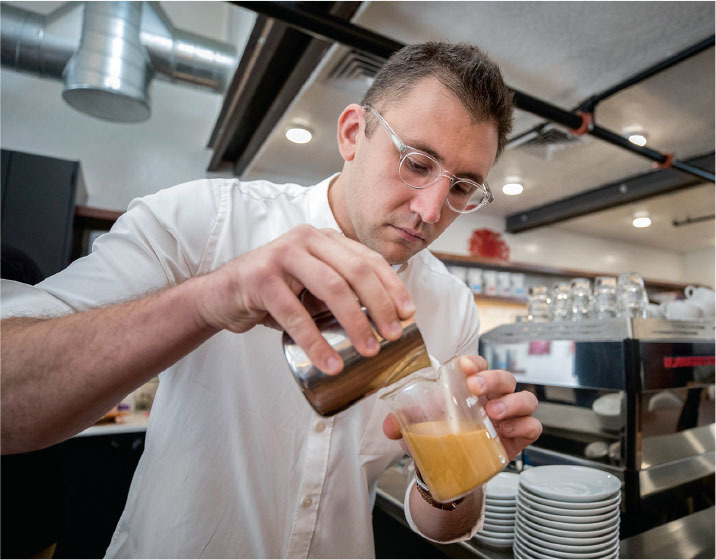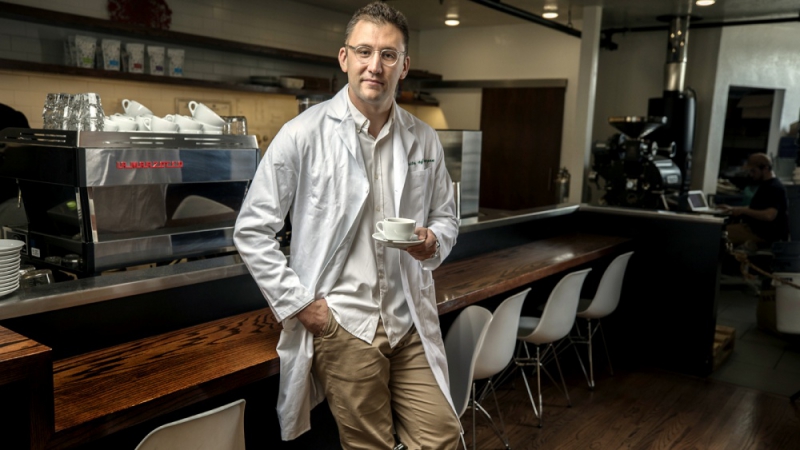Christopher H. Hendon is the Assistant Professor in the Department of Chemistry and Biochemistry at the University of Oregon, but he’s maybe better known as “Dr. Coffee” after taking home the title of ‘Best Signature Beverage’ at a World Barista Championship. We chatted to Dr. Hendon to find out more about his work and passion for coffee…

The University of Oregon refers to you as Dr. Coffee - how did that come about?
“The stars seem to have aligned. My birthday happened to fall on International Coffee Day in 2017 (the year I started at UO), and they thought it might be nice for them to do a press release to celebrate this. I am also founding a coffee lab, so they are on board with this, too. Think something like the Davis Lab, but more like a café setting – applied research.”
You wrote a book with Maxwell Colonna-Dashwood – what is “Water for Coffee” about?
“The chemistry of water and its impact on perceived flavour of coffee extracted with this water. The purpose of the book, at its time of writing, was to teach people about the differences in water and how two coffee experiences could be tremendously different by varying only the water chemistry.”
How did you get interested in coffee?
“During my PhD, I entered Colonna and Smalls and became friends with Maxwell and his wife, Lesley. They taught me everything. I found it compelling, and the idea of sharing knowledge complimented my mission as a scientist – to improve science literacy in the general public.”
You’ve said that coffee is an excellent vehicle to teach fundamental science – how so?
“Everyone on earth knows at least one chemical in coffee – caffeine. But to access it, you can teach fundamental thermodynamics and kinetics (i.e. temperature and time). You can teach chemical properties, such as the solubility. You can illustrate many of the operative principles in chemistry through the lens of coffee. Also, people simply like coffee!”
Tell me about “the God Shot” – what is that exactly?
“The God Shot is a concept that I did not coin. It was supposed to represent the rare event when all the variables (grind setting, coffee dose, mass of water, flow rate, etc. etc.) come together and the coffee is remarkable. By virtue, it has fabled irreproducibility. I aim to minimise these difficulties to achieve consistently tasty coffee.”
What is your coffee of choice?
“A so-called one-and-one. A split shot, where half is served as espresso and the other half as a small milk drink. This way I get to taste a pretty good cross-section of what customers are tasting, and also see how the coffee is standing up as both espresso and in milk.”
I’m really interested in the signature beverage you created for the World Barista Championship – I love a good Pinot Noir! What inspired that pairing?
“The coffee! Sometimes you taste a coffee and its flavour profile reminds you precisely of a flavour gamut. In this case ,we knew what flavours we needed, and we knew a product that contained it – pinot! After doing a lot of literature searching, we put it together and got the chemistry of non-wine stuff to taste like wine.”
The signature beverage is an inspired creation combining espresso and any other non-coffee ingredients except for alcohol. Together with his partner, the 2015 UK barista champion, Maxwell Colonna-Dashwood, Dr. Hendon wanted to pair a washed Ethiopian espresso featuring tannic, fruity, and tea-like flavours with a rotary evaporated bottle of 2014 Château du Santenay Pinot Noir (a wine with similar flavours to the espresso). The alcohol prohibition presented them with a unique challenge: leveraging their backgrounds in chemistry to recreate the flavour of the Pinot Noir…
You approximated the wine using water extraction – how does this work, and how long did it take you?
“It was very fast. Once you know what you are going after, the chemistry becomes quite straightforward. A particular tannin has the same chemical structure, independent of whether it came from wine or walnut. We only iterated twice, I believe.”

Hendon and Colonna-Dashwood recreated the flavour of the Pinot Noir with only four ingredients: a water extraction of the skins of black grapes (for color and grape flavours), cranberries (for mild tannins, fruity acids and tartness), pomegranate (for fruity flavours and natural sugars), and the key ingredient, the second wash of the white, flaky skin of walnut, a source of extremely high levels of tannins.
The pairing of coffee and chemistry definitely paid off in this instance, and we look forward to seeing the research that comes out of Dr. Hendon’s coffee lab in the future!